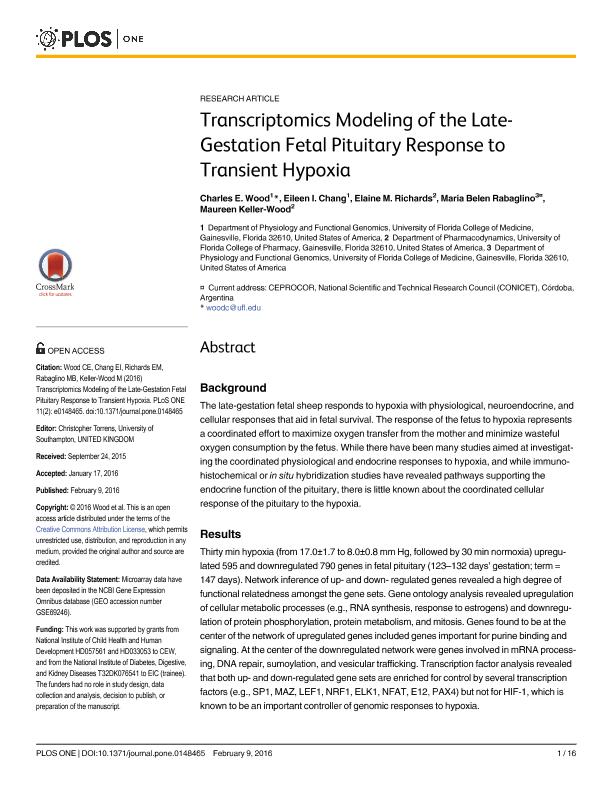Mostrar el registro sencillo del ítem
dc.contributor.author
Wood, Charles E.

dc.contributor.author
Chang, Eileen I.
dc.contributor.author
Richards, Elaine M.
dc.contributor.author
Rabaglino, Maria Belen

dc.contributor.author
Keller Wood, Maureen

dc.date.available
2022-11-30T16:03:44Z
dc.date.issued
2016-02
dc.identifier.citation
Wood, Charles E.; Chang, Eileen I.; Richards, Elaine M.; Rabaglino, Maria Belen; Keller Wood, Maureen; Transcriptomics modeling of the late-gestation fetal pituitary response to transient hypoxia; Public Library of Science; Plos One; 11; 2; 2-2016; 1-16
dc.identifier.issn
1932-6203
dc.identifier.uri
http://hdl.handle.net/11336/179567
dc.description.abstract
Background The late-gestation fetal sheep responds to hypoxia with physiological, neuroendocrine, and cellular responses that aid in fetal survival. The response of the fetus to hypoxia represents a coordinated effort to maximize oxygen transfer from the mother and minimize wasteful oxygen consumption by the fetus. While there have been many studies aimed at investigating the coordinated physiological and endocrine responses to hypoxia, and while immunohistochemical or in situ hybridization studies have revealed pathways supporting the endocrine function of the pituitary, there is little known about the coordinated cellular response of the pituitary to the hypoxia. Results Thirty min hypoxia (from 17.0±1.7 to 8.0±0.8 mm Hg, followed by 30 min normoxia) upregulated 595 and downregulated 790 genes in fetal pituitary (123-132 days' gestation; term = 147 days). Network inference of up- and down- regulated genes revealed a high degree of functional relatedness amongst the gene sets. Gene ontology analysis revealed upregulation of cellular metabolic processes (e.g., RNA synthesis, response to estrogens) and downregulation Conclusions The multiple analytical approaches used in this study suggests that the acute response to 30 min of transient hypoxia in the late-gestation fetus results in reduced cellular metabolism and a pattern of gene expression that is consistent with cellular oxygen and ATP starvation. In this early time point, we see a vigorous gene response. But, like the hypothalamus, the transcriptomic response is not consistent with mediation by HIF-1. If HIF-1 is a significant controller of gene expression in the fetal pituitary after hypoxia, it must be at a later time.
dc.format
application/pdf
dc.language.iso
eng
dc.publisher
Public Library of Science

dc.rights
info:eu-repo/semantics/openAccess
dc.rights.uri
https://creativecommons.org/licenses/by-nc-sa/2.5/ar/
dc.subject
OVINE FETUS
dc.subject
PITUITARY
dc.subject
MICROARRAY
dc.subject
HYPOXIA
dc.subject.classification
Biología del Desarrollo

dc.subject.classification
Ciencias Biológicas

dc.subject.classification
CIENCIAS NATURALES Y EXACTAS

dc.title
Transcriptomics modeling of the late-gestation fetal pituitary response to transient hypoxia
dc.type
info:eu-repo/semantics/article
dc.type
info:ar-repo/semantics/artículo
dc.type
info:eu-repo/semantics/publishedVersion
dc.date.updated
2022-11-30T12:08:20Z
dc.journal.volume
11
dc.journal.number
2
dc.journal.pagination
1-16
dc.journal.pais
Estados Unidos

dc.journal.ciudad
San Francisco
dc.description.fil
Fil: Wood, Charles E.. University of Florida; Estados Unidos
dc.description.fil
Fil: Chang, Eileen I.. University of Florida; Estados Unidos
dc.description.fil
Fil: Richards, Elaine M.. University of Florida; Estados Unidos
dc.description.fil
Fil: Rabaglino, Maria Belen. Consejo Nacional de Investigaciones Científicas y Técnicas. Centro Científico Tecnológico Conicet - Córdoba; Argentina
dc.description.fil
Fil: Keller Wood, Maureen. University of Florida; Estados Unidos
dc.journal.title
Plos One

dc.relation.alternativeid
info:eu-repo/semantics/altIdentifier/url/http://journals.plos.org/plosone/article?id=10.1371/journal.pone.0148465
dc.relation.alternativeid
info:eu-repo/semantics/altIdentifier/doi/http://dx.doi.org/10.1371/journal.pone.0148465
Archivos asociados
